Prakriti: A Gamified Approach to Saving Water
Journal of Engineering Research and Sciences, Volume 1, Issue 2, Page # 33-40, 2022; DOI: 10.55708/js0102004
Keywords: Interactive Learning, UN sustainability Goals, Water Resource Management, Playtesting
(This article belongs to the Section Environmental Engineering (EVE))
Export Citations
Cite
Bhattacharya, T. , Peng, X. , Joshi, I. , Cao, T. , Mao, J. and Qin, X. (2022). Prakriti: A Gamified Approach to Saving Water. Journal of Engineering Research and Sciences, 1(2), 33–40. https://doi.org/10.55708/js0102004
Tathagata Bhattacharya, Xiaopu Peng, Ishita Joshi, Ting Cao, Jianzhou Mao and Xiao Qin. "Prakriti: A Gamified Approach to Saving Water." Journal of Engineering Research and Sciences 1, no. 2 (March 2022): 33–40. https://doi.org/10.55708/js0102004
T. Bhattacharya, X. Peng, I. Joshi, T. Cao, J. Mao and X. Qin, "Prakriti: A Gamified Approach to Saving Water," Journal of Engineering Research and Sciences, vol. 1, no. 2, pp. 33–40, Mar. 2022, doi: 10.55708/js0102004.
1. Introduction
Earth comprises 71% water in which only 3% of freshwater. In that 3% of fresh water, only 1.5% of freshwater is accessible to the human being, rest is stored in the form of ice on the glaciers or mountain cap. More than half a billion people face water crisis every year throughout the world. Therefore, to bring a panacea to the globe, people should be aware of how to use and save water for their future. Today, hydrology and water management become a significant part of research as water depletion has taken a devastating form. The recent trend illustrates that we should incorporate interdisciplinary research to bring a panacea in today’s water scarcity problem. We can approach this problem by:
- Making people aware of the interaction between man and nature
- Through technical skills, design entertainments that will engage people and teach them about how to minimize water consumption.
With the progress in science and technology, we believe it is possible to make people aware of the water depletion and iceberg melt in the poles. Since 1967, the link between social science and water resource education has been a prime highlight. The main motivations of this paper mentioned as follows:
- Motivation1: Build an interesting game that will attract and engage players.
- Motivation2: Bring awareness among the players on water consumption through the game.
- Motivation3: Introduce dramatic elements and formal elements of the game to increase the degree of competition and challenge.
If we discuss about preexisting environmental games like H2O Yeah or The River Basin, we will see that these games profoundly advocate for the need to conserve water. These games have successfully taught how to save or preserve the freshwater resource. Here lies the uniqueness of our game. Prakriti not only teaches the players about the need for water conservation through a joyful experience, but it also provides solutions that we can include in our day-to-day life to conserve freshwater resources. For example, it takes gallons of water to make toilet papers, but instead if we use jet spray in our washroom, we can conserve more water. Therefore, we can say that Prakriti is a unique game that not solicitously provide an opportunity to the players to learn why we need to conserve water and how we can preserve water to bring the panacea in the entire world. Also, in future we would like to update this game through series of evaluations in order to make it more sustainable, interactive, engaging and fun. As an example, we may say that, in the third phase of rapid application development process, we have introduced the cards as the dramatic element that would determine the luck of the players. These cards will either make you save water, or it may make you lose water units. Therefore, we believe with each iteration of software development process we may end up having a better version of the game in future. Also, as a future direction, we may contribute or fusion the conservation of other natural resources like fossil fuel. Our future work would be focused on but not limited to resource conservation and ensuring sustainability.
- Affordable clean energy: water electricity initial water units to win the game [1].
- Sustainable cities and communities: Purifying water talks about Water Resource pollution Adoption (WRA) and the importance of promoting it
- Climate action: Affordable and scalable solution worldwide. It emphasizes cross-cultural education, • Life below water: Conscious management of water responsibility for managing the water resource, maintaining resource the public benefit and empathy and negotiating thinking.
- Life in the land: Encourages afforestation.
- Clean water and sanitation: Distribution of fresh waste.
As the consciousness started growing, interdisciplinary approach in understanding the relationship between water and society and in developing water policy led to the establishment of the concept of Integrated Water Resources Management (IWRM). The emergence of the concept of sustainable development in the same period reinforced the call for interdisciplinary approaches in teaching. In practice, interdisciplinary research slowed down due to the traditional form of teaching. Most of the countries put the concept of water management as a part of Geography or civil engineering. This results in the ignorance of people about water consumption [2]. Good health and well-being: This game teaches innovative ideas to remove water borne diseases and heir cure .Further we will do some literature survey to understand the concepts of pre-existing games and their types.
2. Literature Review
2.1. Electronic Games to reduce water consumption
In [3] author represents a derived study that represents how people compare their actual water consumption with that of forecasted water usage through a board game. Unlike Water-wise, this game derives from a game “Push your luck”. The game comprises of one protagonist and one antagonist. The whole game revolves around drawing cards continuously until they meet the risk condition. This game uses scanning the QR code in the monster card with a smart mobile device. If the player answers the questions correctly, the negative points on the monster card turn into positive ones. This whole scene takes place on the cloud. Whereas, Water-wise is a Simple board game with a board with lots of concentric circles, four players, chores written on the tile and cards that boost the player’s score. This game teaches water consumption in every move of the players. It creates a challenge as well as competition among the players to go to the end and select the correct card to gain more water units.
In [4], [5] and [6], the author discusses the game Drop which is created by SmartH2O research. The motto of the game is to save water. This technique compares the data collected by smartH2O and compares that data with the daily usage of the people in the town. This game determines ideal water usage and teaches people how they can reduce water consumption to save water. But the difference between our game and this game lies in the technique. Our game involves several ways to reduce water consumption by not negatively affecting our personal and social life. Along with that Prakriti is more user interactive and engaging. The players learn ways to save water while playing the game.
In [7], the author depicts the role two games; The River basin and The Globalization of Water role Play. Both these games represent different aspects of the water-saving approach. The first game experiences the user the risk of over utilization of water in the river basin and how that affects the person, society and the mutual interest among people. The second game makes the players familiar with the global dimension of water management. These two agriculture, industry, and public sector and playing the role of a water resource-related organization. Unlike to the previous games Prakriti provides a joyful experience among players by introducing ways to conserve water. It creates tension and thrill among the play testers to win and to save as much water as possible. This technique brings novelty and life in the game.
2.2. Traditional Board Games to reduce water consumption
In [8], the author Tells that board games are introduces in corporate settings since ten years but are not yet widely used. In general, the true value and impact of board games designed for learning are unrecognized by most people. This paper presents some of the myths, specific solutions, and current research showing the power of certain types of board games to facilitate rapid learning and retention and the impact of “Pay for Performance.” Board games are an important tool to provide hands-on and heads-on skill and knowledge development for people of all ages on all subjects. Not only do well-designed games create an engaging atmosphere, but they also provide a nonthreatening, playful, yet competitive environment in which to focus on content and reinforce and apply to learn. Mistakes are useful and point out what we need to learn. Game elements, discussions, and problem-solving with fellow team members about the content are vehicles for learning. Board games provide exceptional, cost-effective resources. Similarly, Prakriti is an aesthetically sound board game that helps players to chill and relax. With its super engaging techniques Prakriti is designed for families on a dining table. Playing the game with friends and family provides utter joy and feel of comfort and warmth among the players during their leisure.
2.3. Tabletop and Shared Display Games
In [9] and [10] the author Say tabletop displays allow people to sit around a shared display, facilitating group work. One advantage of tabletop displays is their support for face-to-face collaboration: with traditional computer monitors, people must sit shoulder to-shoulder to view the display. There are many aspects of tabletop displays to which board game designs can be applied. These can be grouped as follows: recognizability of graphical objects under various orientations; accessibility of display for interaction; demarcation of individual and shared space; and creation of public and private display areas. Prakriti is used as a shared display game. Because of its multiplayer approach it involves several players in the game and through shared display the game. Brings thrill, excitement and enjoyment among the players. Each move, each card is visibly shared among the play testers for a better clarity and honest vision.
2.4. Mobile Games
In [11] the author describes the purpose of this study is to implement a popular board game Turn Up the Heat incorporates a tablet computer app. The game playfully confronts power dynamics associated with the use of residential thermostats to control heating and cooling systems. The tablet computer app simulates a household heating and cooling system and gives all players (parents and children alike) the opportunity to adjust a thermostat on their turn. In [12]-[14], the authors tried to design a board game to encourage families to face largely energy usage problems playfully in their daily family practice and create opportunities for informal intergenerational learning around sustainability issues. Energy monsters go through a repetitive process in which many prototypes are developed and tested. They have listed two versions of the game for families to test at home. Both versions of the game contain traditional tangible elements, such as cards, tokens, and tiles that make up the game board. In the second design, however, they used the iPad app as an integral feature of play to the end-user. Considering that the users make decisions according to their concern and environmental awareness in conjunction with the belief that their actions shall be beneficial and effective making this aspect of utmost importance. The design strategy focuses on giving the users a tangible experience to make the players make changes for real. The game is a continuous parallel system that tracks the energy consumption of households. The players must choose between two groups, namely, Yellow or Blue. Competition is sparked in the game between the two factions through constant comparison. Researchers have particularly emphasized the importance of authentic and relevant real-world tasks in learning, social aspects of education, mediation skill through peer interactions. Researchers have stated that when their learning technique was based on real-world tasks and previous experiences, students were able to actively participate and retain knowledge. The major difference between pervasive games and traditional simulations is the extension of the gaming experience brought to the physical world. Hence, the developers don’t need to build a game world. Instead, we can adapt to the real-world environment and objects into the game (augmented reality). Usually, the games make use of technologies such as adhoc computing networks and satellite positioning to link the devices together and track them along with the users in a physical environment. Pervasive games are trying to incorporate the virtual game world into our everyday physical spaces. Pervasive learning games extend the game world into the real world. However, ours is a board game so it doesn’t implement a game world but equally tries to implement changes into the day to-day life of the players [15]. In [16], the authors express that in recent years, to raise awareness especially in the younger population regarding environmental issues and to stimulate pro-environmental behavior, designers have come up with various games that incorporate our daily life choices and crisis. We sincerely hope that our game not only targets the younger crowd but a larger demographic since ours is a board game along with a software version. Examples of these include energy management simulations, multiplayer pervasive games, etc. Some games require visualizations of data relating to energy consumption such as charts and gauges. Design choices for the game get dominated by game-specific requirements.
3. Design Document
The design document comprises of 3 subsections. We describe the subsections below:
3.1. Wireframe
We design the wireframe as follows: The wireframe suggests that initially each of the players are assigned with x unit of water. Each player is represented by pawns, and they have cards, die as their formal element. Once the die rolls out even, players start playing. Based on the room of the board, they either loose water unit by doing some chores or the cards save them by teaching how to save water or moving them into the inner circle. The goal is to reach to the end and having maximum unit of water.
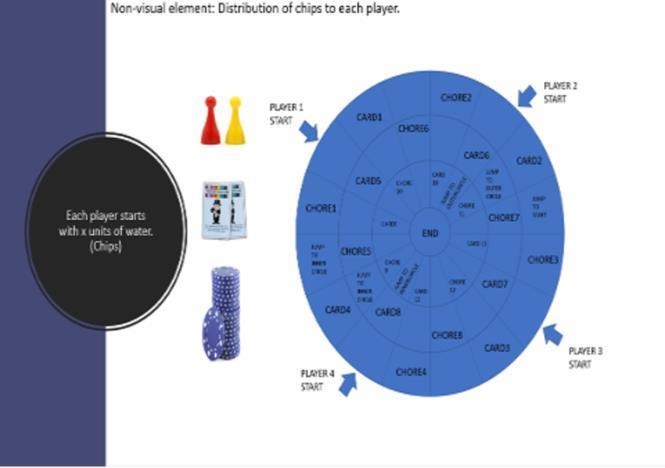
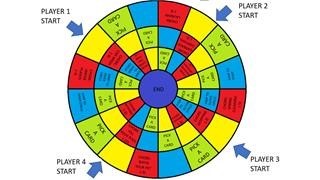
3.2. Conceptual Model
The conceptual model (Fig 2) provides a detailed diagrammatic view of each move of a player in the game. Figure3 to Figure 7 illustrates the player movement in the game from beginning to the end. Two players will enter their field of play that is represented as a circular path circles). They begin on the outer circle, each player at a different location and travel in a clockwise direction, and once they have completed a circle, they enter the next outer most circle and so on until the reach the innermost circle. The player who has the maximum number of water units saved when they reach the center is the winner.
3.3. Software Requirements:
To execute this project, we incorporate the following software: Unity and C#. The software development process uses the Rapid Application Development (RAD) method. We rapidly develop each phase of the game and deliver the final product iteratively. Figure 9 depicts the software development flow of the game. We describe some moves of the players in the game in the following images:
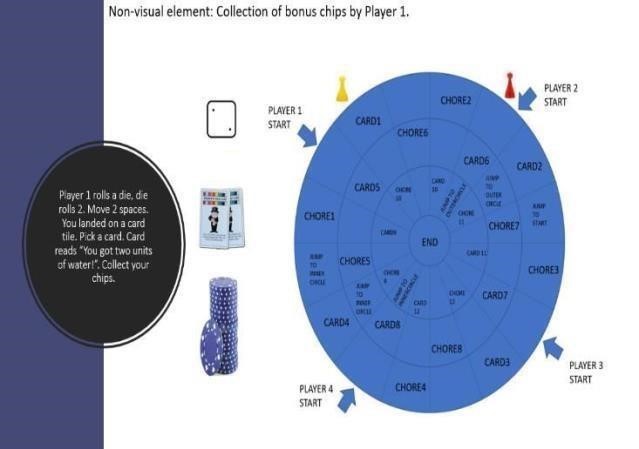
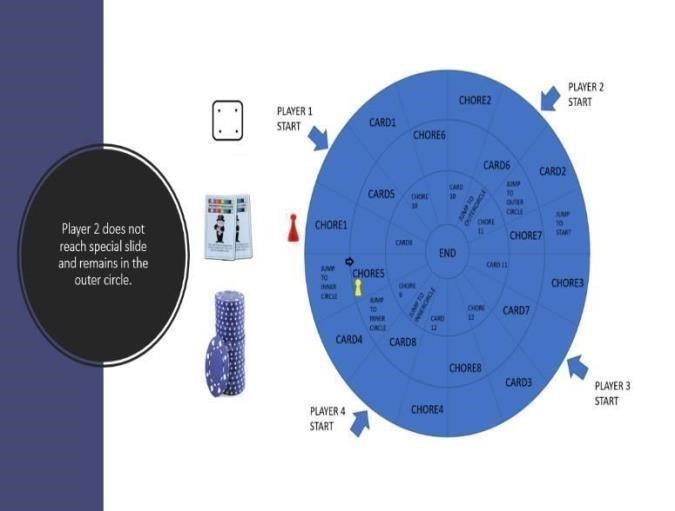
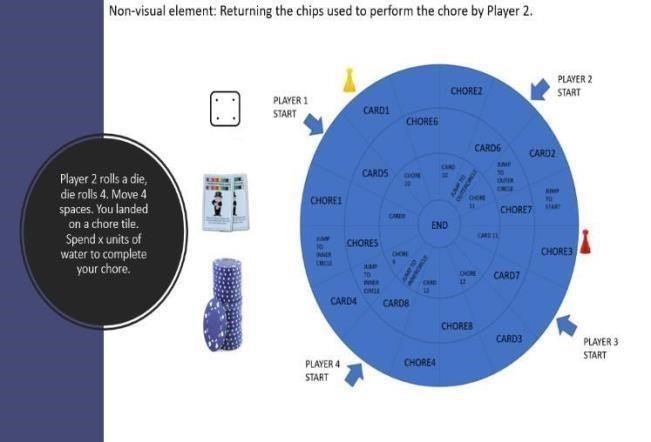
4. Evaluation
The aim of developing the game water-wise is to spread social awareness as well as make the game enigmatic, fun and engaging. Therefore, to playtest our game, we arrange a few playtesting sessions. After each of these playtesting sessions, we collected the playtesting data from each player. We prepared a series of questions in order to understand the demographic as well as the experiences of each player.
4.1. Evaluation methods
To evaluate the game, we used both co-discovery and remote testing methods. In a co-discovery method, 2 to 3 players playtest the game simultaneously. Each of them figures out the rules, procedures of the game together and share their experiences. Whereas in a remote testing method a player remotely playtests the game and submit their feedback. We adopt both methods to find out the following impressions.

- The level of difficulty for the game
- The level of difficulty to understand the rules and procedures of the game.
- The magnetic power of the game.
Table 1: Results of pre-Questionnaire
Criteria | Value | Comments |
Age | 15-21 | Most of the play testers are students |
Sex | Male- 24 | Most of the players |
Female-9 | are men | |
Marital Status | Mostly unmarried | Only 3 to 4 play testers are married |
Awareness | 57% | They are mostly not aware about the global pollution and climate change |
Education level | Undergraduate- 10 Graduate-11 | They are keen on game designing |
Nature lover | 98% | Only few play testers claimed they are not nature lover |
4.2. Pre Questionnaire:
We incorporate pre-questionnaires to find the basic background of the players. These questions include age, sex, gender marital status, awareness, education level, etc. To broadcast the detailed view, we represent the data in Table1.
Once we collect the data for the background of the play testers, we move forward and prepare another set of pot questionnaire for the play testers.
Table 2: Post Questionnaires
Question | Feedback(Iteration1) | Feedback(Iteration2) |
Complexity | 3 | 5 |
Design | 7 | 9 |
Rules | 4 | 6 |
Previous Experience | 6 | 8 |
Uniqueness | 9 | 10 |
X factor | 6 | 9 |
Nature lover | 5 | 7 |
4.3. Post Questionnaire:
Post questionnaires are designed to evaluate the player’s experience once they finish their playtesting session. As we take the Rapid Application Development model approach to develop the software, we incorporate the post questionnaires after each iteration of the development procedure. These questions include interrogations about the complexity of the game, the game rules, the difficulty level of the game, the material of the game, the techniques of the player’s move, the player interaction, etc. It becomes easier to modify the game based on the feedback after each iteration. We mention some of the feedbacks for 2 iterations in Tables 2.
Table2 evaluates each aspect of the game in different iterations. It can be seen that with each iteration the game design, board design, the x-factor and the other elements of the board game is taking a better shape. Sometimes, a few aspects were reviewed as poor than before, but in the next iteration we try to resolve the issue and make Table4: Feedback from iteration2 it better.
4.4. Feedbacks
We prudently review and work on each of the reviews we get from the play testers after each iteration of the playtesting session. We try different testing methods like the think-aloud method, co-discovery method, coach method to evaluate the game from every possible dynamic. Table 3, 4 depict the feedback after each iteration. The positive and negative feedbacks help us to consider software prototype repeatedly and the questions help us to build stronger Fig 8, 9 and 10 provide the screenshots of the final game. Directions, rules, and procedures for the game. We collected two-gallery walks as feedback. At least 30 people play tested the game. We describe the feedback below: We describe a few steps of the game in the above figures. The figures describe the die and the pawn movement, score update, card selection as well as the winner.
Table 3: Feedback 1
Positive | Negative | Interrogations |
Concept was good | Incomplete board | Challenges |
Unique concept | Card description absent | Card function |
Local level of social awareness | Ending strategy not clear | How tiles can be named |
Unique board design | Tiles need to be designed properly | Need more chores |
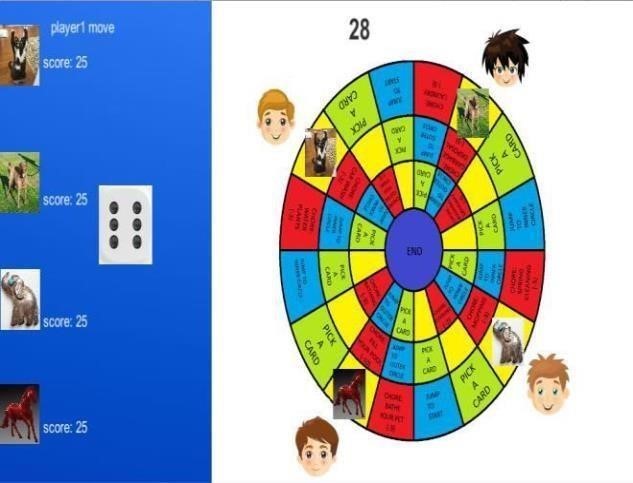
Table 4: Feedback 2
Positive | Negative | Interrogations |
Positive | Negative | Interrogations |
Teaches water conservation | Needs more interactions | Board design |
Unique tile design | Reduce difficulty level | Introducing dramatic elements |
Cards are fun | Difficult to reach end | Why some tiles are empty? |
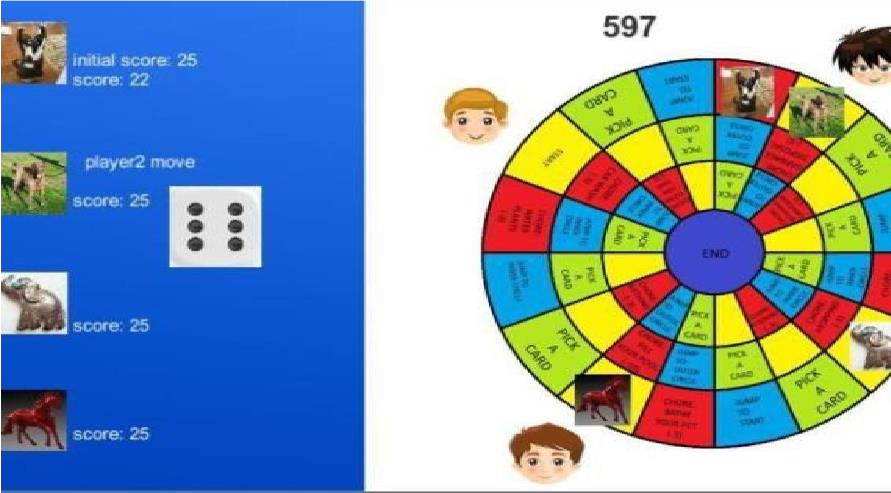
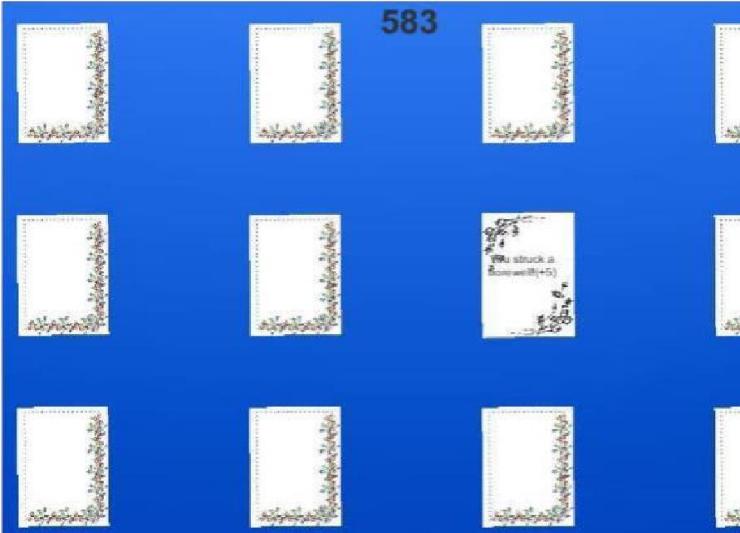
5. Conclusions
Prakriti is designed for educational purposes. It is a shared display, visually aesthetic, engaging and interactive software based board game. Prakriti supports UN sustainable goals by facilitating water conservation strategies and water conservation awareness. It is of utmost importance that we support this game and make it public aware so that people can get a thrilling, engaging and joyful experience of learning water conservation through a gamified approach during this Covid pandemic. Our game Prakriti makes the play testers time thrilling, fun and happy.
Conflict of Interest
The authors declare no conflict of interest.
- Arimoro, Augustine Edobor, and Habibah Musa. “Towards sustainable water resource management in rural Nigeria: The role of communities.” Journal of Sustainable Development Law and Policy (The) 11.1 (2020): 1-17.
- Xiang, Xiaojun, et al. “Urban water resource management for sustainable environment planning using artificial intelligence techniques.” Environmental Impact Assessment Review 86 (2021): 106515.
- Fraternali, Piero, et al. “Integrating real and digital games with data analytics for water consumption behavioral change: a demo.” 2015 IEEE/ACM 8th international conference on utility and cloud computing (UCC). IEEE, 2015.
- Albertarelli, Spartaco, et al. “DROP and FUNERGY: Two gamified learning projects for water and energy conservation.” 11th European Conference on Games Based Learning, ECGBL 2017. Academic Conferences and Publishing International Limited, 2017.
- Besseling, Debbie. “Every Drop Counts-a water game to remember.” Civil Engineering= Siviele Ingenieurswese 2013.5 (2013): 62-64.
- Hoekstra, Arjen Ysbert. “Computer supported games and role plays in teaching water management.” Hydrology and earth system sciences 16.8 (2012): 2985-2994.
- Cheng, Ping-Han, et al. “Development of an issue-situation-based board game: A systemic learning environment for water resource adaptation education.” Sustainability 11.5 (2019): 1341.
- Treher, Elizabeth N. “Learning with board games.” The Learning Key Inc (2011).
- Whalen, Tara. “Playing well with others: Applying board game design to tabletop display interfaces.” ACM symposium on user interface software and technology. Vol. 5. New York: ACM Press, 2003.
- Xu, Yan, et al. “Chores Are Fun: Understanding Social Play in Board Games for Digital Tabletop Game Design.” DiGRA Conference. 2011.
- Horn, Michael S., et al. “Turn Up the Heat! Board games, environmental sustainability, and cultural forms.” Proceedings Games, Learning, and Society, GLS 14 (2014).
- Banerjee, Amartya, Michael S. Horn, and Pryce Davis. “Invasion of the energy monsters: A family board game about energy consumption.” Proceedings of the 2016 CHI Conference Extended Abstracts on Human Factors in Computing Systems. ACM, 2016.
- Grammenos, Dimitris, Anthony Savidis, and Constantine Stephanidis. “UA-Chess: A universally accessible board game.” Proceedings of the 3rd International Conference on Universal Access in Human-Computer Interaction, Las Vegas, Nevada (July 2005). 2005. Harteveld, Casper, and Rafael Bidarra. “Learning with games in a professional environment: A case study of a serious game about levee inspection.” Proceedings of the 1st learning with games (2007): 555-562.
- Rajabu, Kossa RM. “Use and impacts of the river basin game in implementing integrated water resources management in Mkoji sub- catchment in Tanzania.” Agricultural Water Management 94.1-3 (2007): 63-72.
- Bang, Magnus, Anton Gustafsson, and Cecilia Katzeff. “Promoting new patterns in household energy consumption with pervasive learning games.” International Conference on Persuasive Technology. Springer, Berlin, Heidelberg, 2007.
- De Luca, Vanessa, and Roberta Castri. “The social power game: A smart application for sharing energy-saving behaviours in the city.” FSEA 2014 27 (2014).
